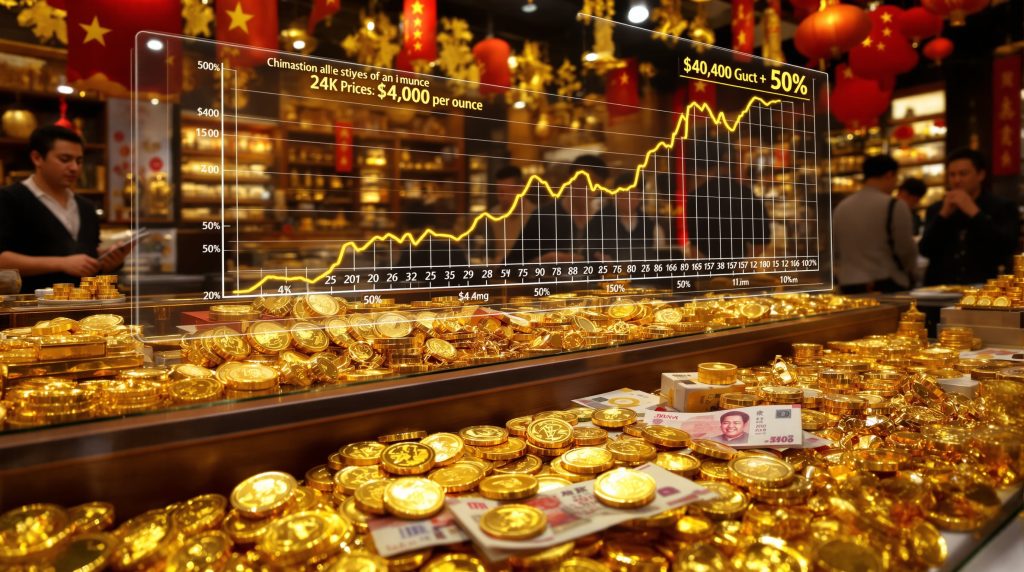China's Gold Buyers Feel the Squeeze as Prices Reach Historic Heights
The unprecedented rise in gold prices to over $4,000 per ounce has dramatically transformed the purchasing landscape for Chinese gold buyers. This 50% surge in 2025 has significantly reduced consumer purchasing power, with many traditional buyers finding themselves priced out of the market they once regularly participated in. The all-time high gold prices have created ripple effects throughout the Chinese economy.
The Numbers Behind the Gold Price Surge
Gold has experienced a meteoric rise throughout 2025, pushing beyond the significant $4,000 per ounce threshold in October. This represents an extraordinary year-to-date increase exceeding 50%, shattering previous records and reshaping the market landscape.
In Chinese currency terms, the impact is even more dramatic. Gold now costs approximately 1,160 yuan ($162.93) per gram, representing an 84% increase from January's price of around 630 yuan per gram. This percentage increase, higher in yuan terms than in dollars, indicates additional pressure from currency factors affecting Chinese consumers.
For average Chinese gold buyers, this price surge has created a stark reality. As Yan Lixiaofeng, who operates a wholesale gold dealer in Shenzhen's Shuibei market, explained, "Before, with 1,000 yuan, our customers could buy about three grams of gold jewelry; now, 1,000 yuan only buys one gram. The difference is huge."
This represents a 67% reduction in purchasing power for average consumers, a dramatic shift that has altered buying behaviors across the country.
Impact on Transaction Volumes
The price surge has had significant consequences for market activity. In China's largest wholesale jewelry market, transactions have declined approximately 60% compared to average years, according to wholesale dealers operating in the region.
Despite the reduced purchasing power, retailers in Shanghai's largest gold markets report that customer traffic remains relatively strong, though the nature of transactions has fundamentally changed. Most purchases now involve trade-ins rather than outright new acquisitions, as consumers exchange older jewelry styles for newer designs to maintain their gold holdings without significant additional expenditure.
What's Driving China's Gold Market Dynamics?
The current gold market in China reflects a complex interplay of global uncertainties, domestic economic challenges, and shifting consumer behaviors that collectively create a unique market environment. Understanding these safe-haven gold dynamics is essential for investors and consumers alike.
Global and Domestic Economic Factors
Gold's record-breaking run has been fueled by multiple factors converging in 2025. Globally, economic uncertainty has intensified the traditional appeal of gold as a safe-haven asset. Ongoing geopolitical tensions have further accelerated institutional investment in precious metals as a hedge against potential market disruptions.
Within China specifically, domestic economic challenges have created additional impetus for gold investment. The prolonged weakness in China's property market has pushed investors to seek alternative stores of value, with gold emerging as a preferred option for wealth preservation in uncertain times.
These combined factors have created strong fundamental support for gold prices, even as the higher prices themselves begin to impact consumer behavior.
Changing Consumer Behaviors
Chinese gold buyers have demonstrated remarkable adaptability in response to the price surge. Rather than abandoning gold entirely, many consumers have strategically adjusted their purchasing patterns.
Trade-in transactions have become increasingly prevalent, with consumers exchanging older jewelry for newer designs rather than expanding their collections through outright purchases. This approach allows them to refresh their gold holdings while minimizing additional expenditure.
There's also emerging evidence of a shift toward more strategic buying focused on investment-grade products rather than purely decorative pieces. The higher prices have prompted many consumers to evaluate gold more critically as a financial asset rather than simply as adornment.
Wang Haichuan, who works at a store in Shanghai's gold market, observed this dual impact: "As far as gold consumption is concerned, it's still generally high, but the recent increase in price is quite significant. The price rise had deterred some, though it had also encouraged others to buy more."
This paradoxical response – where high prices simultaneously deter some buyers while encouraging others to accelerate purchases – highlights the complex psychological dynamics at play in the current market.
How Are Chinese Retailers Adapting to the New Market Reality?
Gold retailers across China are implementing strategic changes to maintain business viability amid dramatically altered market conditions and consumer expectations. The gold market surge has forced industry participants to reimagine their business models.
Retail Strategy Adjustments
With traditional purchasing patterns disrupted by record gold prices, retailers have been forced to innovate. Many have enhanced their trade-in programs, offering more attractive exchange values to encourage continued customer engagement despite reduced purchasing power.
Product innovation has also accelerated, with many retailers introducing lighter-weight gold products that maintain gold's prestige and investment value while achieving more accessible price points. This approach allows price-sensitive consumers to continue participating in the gold market despite financial constraints.
The industry has also responded by expanding product lines featuring lower gold content alongside traditional 24K offerings. This product diversification strategy aims to provide options at various price points, preserving customer relationships even as pure gold becomes increasingly expensive.
Regional Market Variations
The impact of gold's price surge has not been uniform across China. Shanghai's largest gold markets continue to report high customer traffic, though with significantly changed transaction patterns. As previously noted, trade-ins now dominate over outright purchases.
In contrast, Shenzhen's Shuibei wholesale market has experienced more pronounced disruption, with transaction volumes declining significantly compared to previous years. This regional variation may reflect differences in customer demographics, wealth distribution, and the relative importance of wholesale versus retail transactions in different markets.
The adaptation strategies employed by retailers also vary by location. Urban centers with wealthier customer bases have maintained stronger transaction volumes by emphasizing gold's investment value, while retailers in less affluent areas have focused more on product innovation and accessibility.
What Do Chinese Consumers Think About Gold's Future Price Trajectory?
Despite the price squeeze, many Chinese gold buyers remain optimistic about gold's future performance, influencing their current purchasing decisions in interesting ways. According to Reuters' analysis, this optimism continues to underpin market activity.
Consumer Sentiment Analysis
Customer interviews at Shanghai's gold market in October 2025 revealed predominantly bullish sentiment regarding gold's future price trajectory. As Wang Haichuan observed, "Most people think it will continue to rise."
This expectation of continued price appreciation has created interesting dynamics in purchasing behavior. Some consumers are accelerating purchases despite high prices, fearing even higher costs in the future. Others are adopting a more measured approach, making smaller but strategic acquisitions to build their gold holdings gradually.
Customer Zeng Shuangshuang expressed this cautious optimism: "I'm not a financial manager, so I don't know for sure, but I think it will still increase a bit." Another customer, He Meihong, shared a similar perspective: "I think there's still some room for investment opportunities."
This prevailing sentiment that prices have room to rise further has helped sustain market activity despite the significant reduction in purchasing power. It has also shifted the primary motivation for gold purchases increasingly toward investment rather than decoration or tradition.
Strategic Consumer Responses
The combination of high prices and bullish expectations has prompted diverse strategic responses from Chinese consumers. Some are accelerating purchases despite the financial strain, viewing current prices as an opportunity before further increases. Others are more selective, focusing on investment-grade products with maximum potential for appreciation.
There's also growing interest in smaller gram weights and fractional ownership options that allow consumers to maintain exposure to gold's price appreciation potential with more modest financial commitments.
These evolving strategies reflect gold's enduring cultural and financial importance in Chinese society, even as market conditions force adaptation in how that relationship is expressed.
How Is China's Central Bank Influencing the Gold Market?
The People's Bank of China (PBOC) has emerged as a significant player in the global gold market, with its actions both reflecting and influencing broader market trends. The breaking record gold prices have been partly attributed to central bank activity.
Central Bank Reserve Strategy
China's central bank has maintained a consistent gold acquisition strategy throughout 2025, continuing a pattern established in previous years. This ongoing commitment to building national gold reserves signals confidence in gold as a long-term store of value and strategic asset.
The PBOC's gold purchases represent a broader strategy of diversification away from dollar-denominated assets, a trend observed across numerous central banks globally in response to economic uncertainties and geopolitical tensions.
Impact on Domestic Market Sentiment
The central bank's continued gold accumulation has had meaningful psychological impact on domestic market participants. For many Chinese investors, the PBOC's actions represent an implicit endorsement of gold as a strategic asset, reinforcing private investor confidence despite high prices.
This institutional support has been particularly influential among wealthy investors, many of whom have mirrored the national reserve diversification strategy in their personal portfolios. The alignment between central bank policy and private investor behavior has created additional support for gold demand despite price constraints.
What Are Investment Experts Saying About China's Gold Market?
Financial analysts and gold market specialists offer varying perspectives on the current market dynamics and future outlook for gold in China. Many point to the gold price forecast for 2025 as evidence of continued strength in the market.
Expert Market Assessments
Market analysts have offered diverse interpretations of the current gold price trajectory. Some view the rapid appreciation as potentially unsustainable in the short term, suggesting the possibility of price consolidation or correction after such a dramatic surge.
Others point to the structural factors supporting gold prices – including central bank purchases, ongoing geopolitical uncertainties, and persistent inflation concerns – as creating a foundation for continued strength in the gold market.
There is broader consensus that Chinese demand remains a crucial factor in global gold price formation, with changes in Chinese consumer and institutional buying patterns having significant ripple effects throughout the worldwide market.
Future Market Projections
Looking ahead, most analysts anticipate a period of price consolidation after the rapid appreciation seen throughout 2025. This would allow the market to digest recent gains before establishing a new baseline for potential future increases.
Expectations for continued central bank purchasing, both by the PBOC and other national institutions, provide underlying support for gold prices even if consumer demand temporarily moderates due to affordability constraints.
The evolving balance between jewelry and investment demand is likely to continue shifting toward the latter, reflecting gold's increasing role as a financial asset rather than primarily a decorative material in the Chinese market. Industry experts at Mining.com have highlighted this shift as a key trend to watch.
How Does the Current Gold Rush Compare to Historical Patterns?
The present gold market situation in China has both similarities and differences when compared to previous gold price surges, providing context for understanding current market behavior.
Historical Context and Comparisons
While gold has experienced significant bull markets previously, the current price levels substantially exceed all historical precedents. This unprecedented territory makes direct historical comparisons challenging, though certain behavioral patterns remain consistent.
The 2011-2013 gold bull market saw similar initial consumer hesitation as prices reached what were then record levels. However, the market eventually adapted with product innovations and changed purchasing patterns, suggesting potential pathways for adaptation in the current environment.
Similarly, the 2008 financial crisis drove comparable safe-haven demand for gold, though today's market features more sophisticated investment products and broader participation across Chinese society.
Lessons from Previous Cycles
Historical patterns suggest that consumer adaptation typically follows the initial price shock, with the market developing new equilibriums as participants adjust their expectations and behaviors. Product innovation has consistently emerged during previous high-price environments to address changing market realities.
Previous cycles also indicate that periods of rapid price appreciation are often followed by consolidation phases, providing opportunities for market participants to adjust strategies and rebuild demand patterns based on new price realities.
Central bank policies have historically provided important signals about medium-term price directions, making the PBOC's continued purchasing particularly significant for market sentiment and expectations.
What Alternative Options Are Chinese Gold Buyers Considering?
As traditional gold purchasing becomes less accessible, Chinese consumers are exploring alternative approaches to maintain their connection to this culturally and financially important asset.
Emerging Alternatives to Traditional Gold Buying
Gold-backed financial products have gained increasing attention as alternatives to physical gold ownership. These include gold-backed exchange-traded funds (ETFs) that allow investors to gain exposure to gold price movements without physical storage requirements.
Digital gold accounts offering fractional ownership have also emerged as convenient options for investors seeking gold exposure with smaller investment amounts. Major Chinese banks have introduced gold-linked wealth management products that provide gold price exposure within more diversified investment portfolios.
Some investors have also explored relative value opportunities in other precious metals, with silver and platinum attracting interest as potentially undervalued alternatives to gold.
Innovation in Physical Gold Products
On the physical product side, jewelers have responded to price pressures with significant design innovations. Lighter-weight jewelry designs that maintain gold's visual impact and cultural significance while using less raw material have gained popularity.
There's also growing emphasis on craftsmanship and design value, with some consumers willing to pay premiums for artistic merit rather than just raw gold content. This shift allows the industry to maintain value propositions even as raw material costs increase.
Navigating China's Gold Market in a High-Price Environment
The record-breaking surge in gold prices has fundamentally altered China's gold market landscape, creating both challenges and opportunities for consumers, retailers, and investors. While the dramatic reduction in purchasing power has squeezed traditional buying patterns, it has also accelerated market innovation and strategic adaptation.
Chinese consumers have demonstrated remarkable resilience and flexibility in their approach to gold ownership. The shift from outright purchases to trade-ins, exploration of lighter-weight products, and investigation of alternative investment vehicles all reflect the enduring cultural and financial importance of gold in Chinese society.
Retailers have responded with product innovations and enhanced services designed to maintain customer engagement despite price challenges. These adaptations suggest an industry in transition rather than decline, with new business models emerging to address changed market realities.
The continued bullish sentiment among consumers and ongoing central bank purchases indicate that gold will retain its special status in China, even as the market adapts to a new price paradigm. This evolution reflects gold's enduring appeal as both a cultural tradition and financial safe haven, regardless of price fluctuations.
As one market participant aptly observed, the gold market isn't disappearing – it's transforming. The forms and patterns of gold ownership may change in response to economic realities, but gold's fundamental role in Chinese financial culture remains firmly established, ensuring its continued relevance in portfolio diversification, wealth preservation, and cultural expression for generations to come.
Looking to Capitalise on the Next Major Gold Discovery?
Discover how significant ASX mineral discoveries can lead to substantial returns even during fluctuating gold markets by exploring Discovery Alert's dedicated discoveries page, powered by their proprietary Discovery IQ model. Begin your 30-day free trial today at Discovery Alert to position yourself ahead of the market with instant notifications on potentially transformative gold opportunities.




